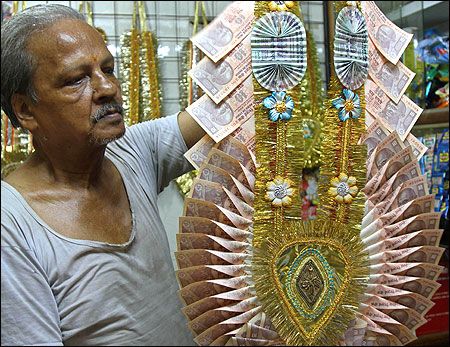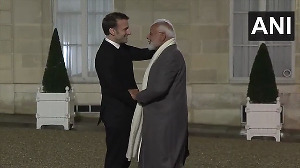 The curious thing is that savings instruments have not really kept pace with changing needs, although people have access to a wider variety than before.
The curious thing is that savings instruments have not really kept pace with changing needs, although people have access to a wider variety than before.
Mumbai resident Girish Gokhale's father would often say his two sons were his savings for the post-retirement days. To that end, the senior Gokhale, a government servant, spent his life's savings on his sons' education.
He certainly needed to rely on his children. His monthly pension was a princely Rs 6,000, hardly enough to make even the most frugal ends meet. Not that his sons questioned their filial responsibilities either; both looked after their parents. This was not an untypical example of middle-class family life two generations ago.
But things were not the same for 62-year-old Gokhale. In his mid-40s he realised he won't be able to rely on his only son for his post-retirement needs. His son travelled to the US for higher studies and settled there with no plans to return. That prompted him to start saving for his retirement.
Like Gokhale, most people know they can no longer view their children as their sole retirement plan. But the curious thing is that savings instruments have not really kept pace with changing needs, although people have access to a wider variety than before.
"Since the 1970s, the mindset of people have changed - from relying on children (mainly their sons) - now many worry about their post-service days themselves. And the number of instruments available for saving has also increased," says Sudipto Roy, business head at Principal Retirement Advisors.
But, he adds, people still don't know how to make the best use of savings instruments for long-term goals like retirement. And the returns on these instruments are not very lucrative.
Through most of the seventies and eighties, says Kartik Jhaveri of Transcend Consulting, government-owned monopolist Life Insurance Corporation (LIC)'s insurance policy was the most preferred due to lack of options. "People also bought LIC's traditional pension policy then - Jeevan Suraksha."
The policy offered a guaranteed bonus at 7.75 per cent and paid 7 to 9 per cent depending on the type of annuity bought.
"Say, you bought Rs 60,000 worth of annuity for which you'd be paid a pension of Rs 6,000. If you tell the insurance company that it need not pay anything to your family after your death then you would get the higher rate of 9 per cent. If you wanted the pension to be continued for your beneficiary after your death, then you would get the lower rate," Jhaveri explains.
Those in service would mandatorily contribute towards Employee Provident Fund (EPF) that earned 6 per cent a year in 1973-74.
Many would also open a Public Provident Fund (PPF) account as a supplementary account for post-retirement needs but financial planners say there were withdrawals in the interim to fund education or marriages.
Investment in PPF has a lock-in of six years and from the seventh year onwards subscribers can withdraw 50 per cent of the accumulated corpus every year till the last or 15th year.
 PPF enjoys Exempt-Exempt-Exempt (EEE) tax treatment similar to EPF, that is, investment and maturity value both are tax-free.
PPF enjoys Exempt-Exempt-Exempt (EEE) tax treatment similar to EPF, that is, investment and maturity value both are tax-free.
Then, bank fixed deposits which offered between 6 and 7.25 per cent in 1973-74 was another popular instrument (see box).
The only equity investment option available pre-1990s was Unit Trust of India's mutual fund scheme, Unit Scheme 1964 (US 64).
This scheme was a huge success with Rs 6,700 crore of assets under management by 1998-end. It paid as high as 14 per cent returns.
But the scheme was mismanaged leading to its closure in 2003. It severely impacted the investors and eroded their faith in equity. Only in the early 1990s private sector mutual fund houses started operations.
This remains the staple savings menu even today. According to certified financial planner Malhar Majumder, the bigger problem is that parents advise children to invest in instruments that they invested in during their time.
"Even today, for instance, the first things parents tell their children to do when they start earning is open a PPF account and buy an endowment policy from LIC. They don't understand these products earn just six to eight per cent annually, and are not suited for those in their 20s," he explains.
Most importantly, most individuals did not understand the effect of inflation over the long term. Annual inflation was 20.9 per cent in 1973-74.
This was an exceptional year as the inflation rate was high as oil producing nations proclaimed an embargo which saw oil prices soar (oil shock of 1973).
According to the Reserve Bank of India, it continued to be more than 20 per cent in 1974. Hence, return on investments were well below inflation rates.
Today, other than PF and deposits, there are many mutual funds schemes that can be a part of your retirement portfolio.
They can earn you 10 -12 per cent annually in 8-10 years or more. According to Value Research, Franklin India Bluechip Fund has returned 19.50 per cent annually in the last 10 years.
HDFC Top 200 has given 22.40 per cent annually. According to Bloomberg, the average CPI has been at 8.28 per cent in the same period, giving substantial returns.
In 2004, government introduced the New Pension System (NPS). It offers Tier 1 accounts (where premature withdrawals are not allowed) and Tier II accounts (where premature withdrawals are allowed). NPS can help you earn high returns due to equity exposure.
Unfortunately tax adjusted returns from debt instruments continue to be less than inflation. A fixed deposit scheme earning 9 per cent annually today, earns 6.3 per cent post tax when inflation is 7.8 per cent.
Hence, there is need to invest in better return yielding instruments for a neat retirement corpus. Also saving for retirement need not happen only through pension paying instruments because annuity rates are 6 to 9 per cent, or 4.3 - 6.3 per cent after tax.
But while people are more aware about saving for retirement, inflation and tax issues, they still hold on to some wrong investment notions. They always believed equities should not be invested in and still believe insurance policies can be invested in for the long term.












 © 2025
© 2025